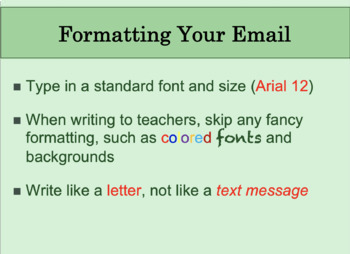

Stick to writing out full words and using layman’s terms to get your point across, although exceptions can be made depending on whom you’re emailing. The Don’ts Don’t: Use buzzwordsĪcronyms and buzzwords can confuse recipients and make you look unprofessional, according to Smith. You can also read our reviews of the best conference call systems to find platforms for phone conversations involving three or more people. Read our guide to choosing the right video conferencing service to find the best platform for your needs. Video conferencing is a feasible alternative to in-person and phone meetings. Doing so could help you avoid an unnecessary altercation, Smith said. Instead, try to calm down and then speak to the person you need to address face-to- face or over the phone if an in-person meeting is not possible. Never send any email while you are angry or otherwise emotional, Smith advised. “Be sure you are saying what you need to say sufficiently.” Do: Keep Calm “Recipients will only read the first line or two before deciding whether to keep or delete ,” Smith said. If your email is too wordy, try editing it down to make it more concise. Emails are not meant to be as brief as text messages, Smith said, but they are meant to be a form of quick communication. It’s always best to keep your emails short and sweet.
#Email etiquette and netiquette software#
“Email software comes with many professional tools such as spell check. “These errors look unprofessional and reduce the likelihood that the email will be taken seriously,” added Schweitzer.

Careless email mistakes will only make you look bad to your recipients. You should look for misspellings, homonyms, grammar and punctuation errors, Smith said. Do: Proofreadīefore you send, make sure to carefully proofread and edit your email. “‘Good day’ or ‘greetings’ are other phrases used frequently in the international arena,” she added. Opening an email with “hi” or “hey” might be alright for colleagues you’re friendly with, but for new contacts, Schweitzer advised beginning your email with a proper, respectful salutation, such as “good morning,” “good afternoon,” “good evening” or “hello.” Smith, owner of etiquette consulting business Mannersmith, and Schweitzer shared their advice for keeping emails proper and professional, including some major dos and don’ts, and when to use the carbon copy (cc) and blind carbon copy (bcc) options. Additionally, automated responses can reduce connections between senders and receivers, and creating more generic rather than customized emails may lead to miscommunication. Yet, quick, casual responses to professional emails can do more harm than good, according to Sharon Schweitzer, founder of Protocol & Etiquette Worldwide. Responding to emails is a necessity in the business world, but taking the time to type out a thoughtful, polite reply to each one can eat up a good chunk of your day. This article is for anyone looking to understand email etiquette.If you can’t do that, a smaller cc or bcc list of people is typically best. If you’re not sure whether to cc or bcc someone on an email, just ask them.You should always close your emails kindly, indicating that the conversation is over. Buzzwords, aggression, meanness and poor punctuation have no place in an email.Avoid email for resolving more tense situations. When writing emails, use proper salutation, proofread what you’ve written before sending it and keep it short but sweet.


 0 kommentar(er)
0 kommentar(er)
